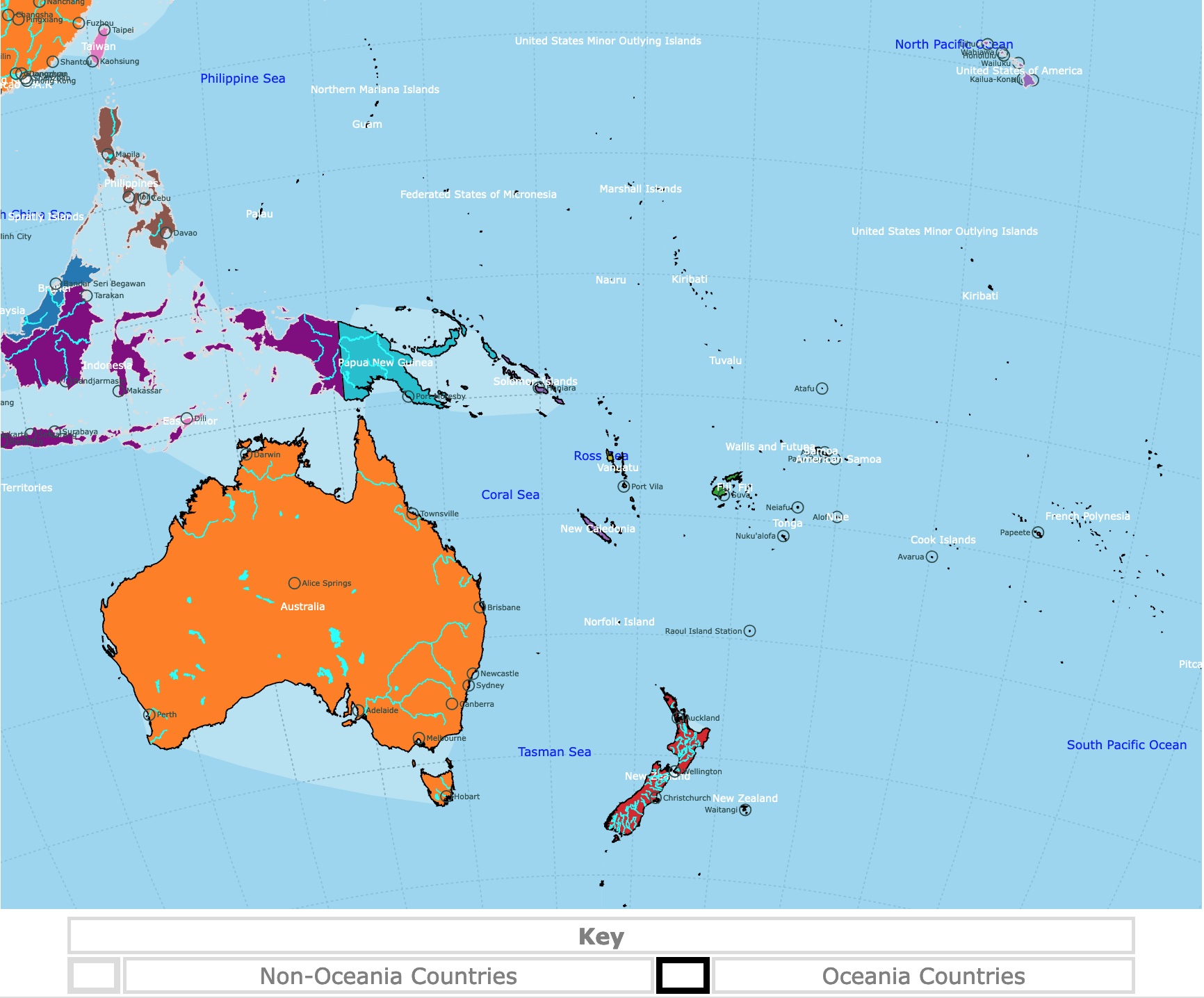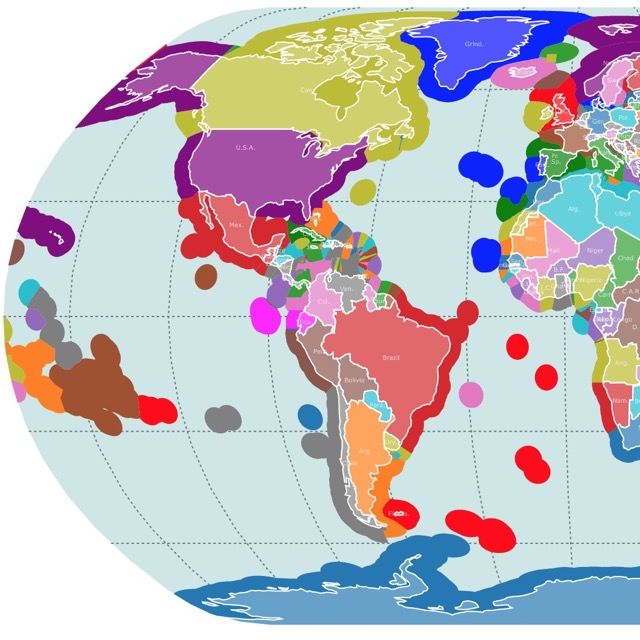Map of All Countries in Oceania
This is an interactive political map of Oceania. It displays islands, countries, rivers, lakes, and cities. Countries in Oceania have a black border. Hover over the map for population, GDP, geography, and river names. To take a closer look, zoom in. For more information, scroll down.
| Key | |||
|---|---|---|---|
| Non-Oceania Countries | Oceania Countries | ||
OCEANIA

Oceania is a geographical region comprising numerous islands, including the continent of Australia, the islands of New Zealand, Papua New Guinea, and the Pacific islands.
It is located in the southwestern Pacific Ocean and is bordered by the Indian Ocean to the west and the Pacific Ocean to the east.
Some may describe this area as the land south of Asia or the area between Asia and the Americas.
Oceania covers an area of more than 100 million square kilometers and more than 10,000 islands.
Oceania has a land area of more than 3,291,000 sq mi (8,525,900 km2.
In English-speaking countries, the continent is known as Australia. In other parts of the world, it is known as Oceania.
For an in-depth look at this continent, Amazon has Oceania: An Introduction to the Cultures and Identities of Pacific Islanders, Second Edition. This book is written collaboratively by experts on different regions of Oceania. It combines surveys of prehistory and history with careful discussions of cultural patterns and problems of this continent.
How Many Countries in Oceania?
There are 14 overseas territories and independent countries in Oceania.
This table has all countries in Oceania, its Regions, Islands, and Capitals
| POLYNESIA | MICRONESIA | ||
|---|---|---|---|
| Island | Capital | Island | Capital |
| American Samoa (US) | Pago Pago | Guam (US) | Hagåtña |
| Cook Islands | Avarua | Kiribati | South Tarawa |
| Easter Island (Chile) | Hanga Roa | Marshall Islands | Majuro |
| French Polynesia (France) | Papeetē | Micronesia | Palikir |
| Hawaii (US) | Honolulu | Nauru | Yaren |
| New Zealand | Wellington | Northern Mariana Islands (US) | Saipan |
| Niue | Alofi | Palau | Ngerulmud |
| Pitcairn Islands (UK) | Adamstown | MELANESIA | |
| Samoa | Apia | Island | Capital |
| Tokelau | Fakaofo | Fiji | Suva |
| Tonga | Nuku'alofa | New Caledonia (France) | Nouméa |
| Tuvalu | Funafuti | Papua New Guinea | Port Moresby |
| Wallis And Futuna | Mata Utu | Solomon Islands | Honiara |
| Vanuatu | Port Vila | ||
Regions of Oceania

Oceania encompasses 4 different regions: Australasia, Polynesia, Micronesia, and Melanesia.
Australasia
The islands and countries that makeup Australasia vary depending on the sources. Australasia includes Australia, New Zealand, and neighboring islands.
Australia
Australia is the largest country in Oceania and the sixth largest country globally. With an area of 7,682,300 sq km, Australia is only slightly smaller than the United States.
Australia is also known as the "Land Down Under". Australia shares no borders with other countries. It only shares maritime boundaries with neighboring islands.
Australia has a vast coastline that stretches over 25,000 kilometers (15,500 miles). It is home to numerous stunning beaches and iconic landmarks such as the Great Barrier Reef.
The Great Barrier Reef is the world's largest coral reef system. It is located on the northeastern coast of Australia. It is a UNESCO World Heritage site renowned for its incredible biodiversity and natural beauty.
Australia experiences a diverse range of climates due to its size. The northern parts have a tropical climate, while the southern areas have a temperate climate.
The central region, known as the Outback, is characterized by arid or semi-arid conditions.
Australia is famous for its unique wildlife, including kangaroos, koalas, wombats, platypuses, and various species of reptiles.
Many of these animals are endemic to the country, meaning they are found nowhere else in the world.
The largest cities in Australia are Sydney, Melbourne, Brisbane, Perth, and Adelaide. Australia's capital is Canberra.
Not sure where to start exploring? Expedia will help you with tickets, accommodation, and prices.
New Zealand
New Zealand is located in the southwestern Pacific Ocean. New Zealand is in 2 regions, Australasia and Polynesia. It consists of two main islands, the North Island and the South Island, as well as numerous smaller islands.
- North Island: This is the smaller of the two main islands but has a higher population. It is known for its diverse landscapes, including geothermal areas, volcanic peaks, beautiful beaches, and rolling farmland. The capital city, Wellington, is located on the southern tip of the North Island.
- South Island: The South Island is larger than the North Island and is renowned for its dramatic landscapes. It features the Southern Alps, which run along the entire length of the island and include New Zealand's highest peak, Aoraki/Mount Cook. The South Island is also home to fjords, pristine lakes, glaciers, and adventure tourism destinations like Queenstown and Fiordland National Park.
New Zealand is home to unique and diverse wildlife, much of which is found nowhere else in the world.
Notable species include the kiwi (a flightless bird and national symbol), kea (an intelligent alpine parrot), tuatara (a reptile resembling a dinosaur), and various endemic species of marine mammals, such as dolphins and seals.
The indigenous people of New Zealand are the Māori, and their culture is an integral part of the country's identity.
Polynesia
Geographically, Polynesia includes the islands within the Polynesian Triangle, which is formed by Hawaii in the north, New Zealand in the southwest, and Easter Island in the southeast.
The triangle encompasses a vast area of the Pacific Ocean and is known for its many archipelagos and isolated islands.
Polynesia, along with Micronesia, is known as Low Islands. This is because these islands are made of skeletons and living bodies of corals.
Sometimes, coral islands barely reach above sea level—hence the name “low island.” Source: National Geographic.
Polynesians share cultural and linguistic similarities, and many aspects of their heritage, such as music, dance, and navigation techniques, have influenced the wider Pacific region.
The islands of Polynesia are known for their stunning landscapes, vibrant traditions, and warm hospitality.
Hawaii
The Hawaiian Islands are located in the northernmost part of Polynesia. They are a state of the United States and have a distinct Polynesian culture and history.
Samoa
Samoa consists of two main islands, Upolu and Savai'i, along with smaller uninhabited islands.
It is an independent country with a rich Polynesian culture.
Toga
The Kingdom of Tonga is an archipelago comprising more than 170 islands, of which only 36 are inhabited.
It is the only remaining Polynesian monarchy and has a strong cultural heritage.
French Polynesia
French Polynesia is an overseas collectivity of France, consisting of several island groups, including the Society Islands (e.g., Tahiti, Moorea, and Bora Bora), the Marquesas Islands, and the Tuamotu Archipelago.
Cook Islands
The Cook Islands are a self-governing territory associated with New Zealand.
The archipelago includes 15 major islands spread over a vast area of the Pacific.
Tuvalu
Tuvalu is a small island nation composed of nine coral atolls.
It is one of the world's smallest countries in terms of both land area and population.
Easter Island
Also known as Rapa Nui, Easter Island is located in the southeastern part of Polynesia.
It is famous for its massive stone statues called moai. This island belongs to Chile, a South American country.
If you find this region captivating, Amazon has Oceania: The Shape of Time. This publication explores the deeply rooted connections between Austronesian-speaking peoples, whose ancestral homelands span Island Southeast Asia, Australia, Papua New Guinea, and the island archipelagoes of the northern and eastern Pacific.
Micronesia
Micronesia is a subregion of Oceania,located in the western Pacific Ocean.
Micronesia is composed of thousands of small islands and atolls scattered across the Pacific. It is divided into several political entities, including independent nations and territories associated with other countries.
Geographically, Micronesia is situated northeast of Papua New Guinea and north of Melanesia. It encompasses the westernmost part of Oceania and is located east of the Philippines.
The region is known for its tropical climate, abundant marine life, and stunning coral reefs.
Many of the island nations rely on fishing, subsistence agriculture, and tourism as economic activities.
The region's stunning natural beauty, including pristine beaches, vibrant coral reefs, and World War II historical sites, attracts visitors from around the world.
Melanesia
Geographically, Melanesia is located northeast of Australia and encompasses the islands situated north and east of New Guinea.
It includes the countries of Papua New Guinea, Solomon Islands, Vanuatu, Fiji, and New Caledonia, as well as smaller island groups and territories.
Melanesia Islands are also called High Islands. This is because they originated from Volcanic eruptions. These islands usually have a central peak from a volcano.
The tectonic activity in the "Ring of Fire" has resulted in the volcanoes of these islands.
Melanesia is characterized by its cultural diversity, with a multitude of indigenous languages, customs, and traditions.
The region is home to various indigenous communities, each with its own distinct cultural practices and art forms.
Traditional activities such as canoe building, weaving, and ceremonial rituals continue to be an integral part of Melanesian culture.
The natural environment of Melanesia is exceptionally diverse, featuring lush rainforests, mountain ranges, volcanic islands, and extensive coral reefs.
The region's unique ecosystems support a wealth of plant and animal species, including rare birds, marsupials, reptiles, and marine life.
Overall, Melanesia offers a rich tapestry of cultures, breathtaking landscapes, and warm hospitality, making it a captivating destination for travelers and a unique part of Oceania's identity.
Resources for Oceania Map
The shapefiles with the world's countries, rivers, lakes, and oceans were obtained from Natural Earth.
This map will be updated with new data! To receive updates on this and more maps, join my email list!!!!!!!
Made by Luz K. Molina with D3.js.








